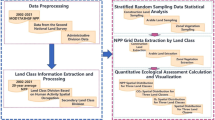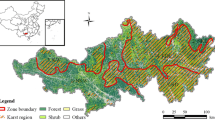Abstract
Karst areas are one of the most fragile regions in the world. The Karst environment is very common in southwest China with severe poverty and environmental degradation. Therefore, it is necessary to monitor the Karst ecosystem and its ability to provide goods and services for society. In this paper, we analyzed the spatial distribution of organic productivity values (OPV) in Northwest Guangxi, China in 1985, 1990, 2000, and 2005 using remote sensing and geographic information system techniques. OPV showed a decreasing trend in the last 20 years though there were fluctuations. OPV was 184.85, 117.53, 163.66 and 177.25 million Yuan in 1985, 1990, 2000 and 2005, respectively. Woodland and shrub were the two largest contributors to total OPV. They accounted for 70.51%, 69.13%, 73.92% and 66.23%, respectively, in those four years. Conversely, OPVof residential and barren rock was low with a percentage of 0.70%, 0.56%, 0.57% and 0.90%, respectively. Spatially, OPVis higher in the west than in the east. However, OPV increased in typical Karst areas but decreased in non-Karst areas. Our study indicates that ecosystem conditions in Karst areas had improved because of the application of rocky desertification control policies.
Similar content being viewed by others
References
Cao J H, Yuan D X, Tong L Q (2008). Features of Karst ecosystem and integrating measure for rock desertification in Southwest China. Pratacultural Science, 25: 40–50 (in Chinese)
Costanza R, d’Arge R, de Groot R, Farber S, Grasso M, Hannon B, Limburg K, Naeem S, O’Neill R V, Paruelo J, Raskin R G, Sutton P, van den Belt M (1997). The value of the world’s ecosystem services and natural capital. Nature, 387: 253–260
Daily G C (1997). Nature’s Services: Societal Dependence on Natural Ecosystems. Washington D C: Island Press
Dong L X, Wang W K, Ma M G, Kong J L, Veroustraete F (2009). The change of land cover and land use and its impact factors in upriver key regions of the Yellow River. International Journal of Remote Sensing, 30: 1251–1265
Government Offices in Baise (2005). The issuance of the policy of returning farmland to forest to honor the notice of the work program of government offices in Baise (in Chinese)
Hu H B, Liu W J, Cao M (2008a). Impact of land use and land cover changes on ecosystem services in Menglun, Xishuangbanna, Southwest China. Environmental Monitoring and Assessment, 146: 147–156
Hu Y C, Liu Y S, Wu P L, Zou X P (2008b). Rocky desertification in Guangxi Karst mountainous area: its tendency, formation causes and rehabilitation. Transactions of the CSAE, 24(6): 96–101
Jiang L P, Qin Z H, Xie W, Wang R J, Xu B, Lu Q (2007). Estimation of grassland ecosystem services value of China using remote sensing data. Journal of Natural Resources, 22: 161–170 (in Chinese)
Li R Q, Dong M, Cui J Y (2007). Quantification of the impact of landuse changes on ecosystem services: a case study in Pingbian county, China. Environmental Monitoring and Assessment, 128: 503–510
Li Y B, Wang S J, Zhou D Q (2005). Research on the ecosystem service evaluation of Maolan Karst forest. Earth and Environment, 33(2): 39–44 (in Chinese)
Liu J Y, Buhe A S (2000). Study on spatial temporal feature of modern landuse change in China: using remote sensing techniques. Quaternary Sciences, 20: 229–239 (in Chinese)
Loveland T R, J W Merchant, Ohlen D O, Brown J F (1991). Development of a land cover characteristics database for the conterminous U.S. Photogrammetric Engineering and Remote Sensing, 1991, 57(11): 1453–1463
Luo J, Wang K L, Chen H S (2008). Economic response of ecosystem service functions to landuse changes in Karst region. Bulletin of Soil and Water Conservation, 28(1): 19–24 (in Chinese)
Millennium Ecosystem Assessment (2003). Ecosystems and Human Well-being. Washington D C: Island Press
Parise M, Waele J D, Gutierrez F (2008). Engineering and environmental problems in Karst-An introduction. Engineering Geology, 99: 91–94
Running S W, Coughlan J C (1988). A general model of ecosystem processes for regional applications 1: hydrologic balance, canopy gas exchange and primary production processes. Ecological modeling, 42: 125–154
Su W C (2002). Controlling model for rocky desertification of Karst mountainous region and its preventing strategy in southwest, China. Journal of Soil and Water Conservation, 16(2): 29–32, 79 (in Chinese)
Thomthwaite C W (1948). An approach toward a rational classification of climate. Geog Rew 38: 55–94
Verstraete M M, Pinty B, Myneni R B (1996). Potential and limitations of information extraction on the terrestrial biosphere from satellite remote sensing. Remote Sensing of Environment, 58: 201–214
Wang X L, Bao Y H (1999). Study on the methods of land use dynamic change research. Progress in Geography, 18: 81–87 (in Chinese)
Wang Z M, Zhang B, Zhang S Q, Li Z Y, Liu D W, Song K S (2006). Changes of land use and of ecosystem service values in Sanjiang Plain, Northeast China. Environmental Monitoring and Assessment, 112: 69–91
Wu K Y, Jiang Z C, Deng X H, Ye Y (2008). Ecosystem service value of restored secondary forest in the Karstic-rocky hills-A case study of Nongla National Medicine Nature Reserve, Guangxi Zhuang Autonomous Region. Chinese Journal of Eco-Agriculture, 16(4): 1011–1014 (in Chinese)
Xiao H, Ouyang Z Y, Zhao J Z, Wang X K (2000). Forest ecosystem services and their ecological valuation-A case study of tropical forest in Jianfengling of Hainan Island. Chinese Journal of Applied Ecology, 11(4): 481–484
Xiong Y, Xie G X, Zeng GM, Wang K L, Yang C H (2008). Influence of Karst emigration region land use change on ecosystem service value-using Guangxi Huanjiang County as example. China Environmental Science, 28(3): 210–214 (in Chinese)
Yang A X, Peng Y (2007). Summary of study on the ecohydrological functions of Karst forest ecosystems in Guizhou. Journal of Anhui Agri Sci, 35(36): 11995–11997, 12037 (in Chinese)
Yang W, Chang J, Xu B, Peng C H, Ge Y (2008). Ecosystem service value assessment for constructed wetlands: A case study in Hangzhou, China. Ecological Economics, 68: 116–125
Ye S M, You Y Y, Zhou C J (2003). Reducing cultivated land to plant forest and grass is a necessary strategy to develop economy and protect environment. Forest Engineering, 19, 1–3 (in Chinese)
Yuan D X, Cai G H (1988). The Science of Karst Environment. Chongqing: Chongqing Science and Technology Press (in Chinese)
Author information
Authors and Affiliations
Corresponding author
Rights and permissions
About this article
Cite this article
Zhang, M., Wang, K., Chen, H. et al. Impacts of land use and land cover changes upon organic productivity values in Karst ecosystems: a case study of Northwest Guangxi, China. Front. Earth Sci. China 4, 3–13 (2010). https://doi.org/10.1007/s11707-010-0005-9
Received:
Accepted:
Published:
Issue Date:
DOI: https://doi.org/10.1007/s11707-010-0005-9




